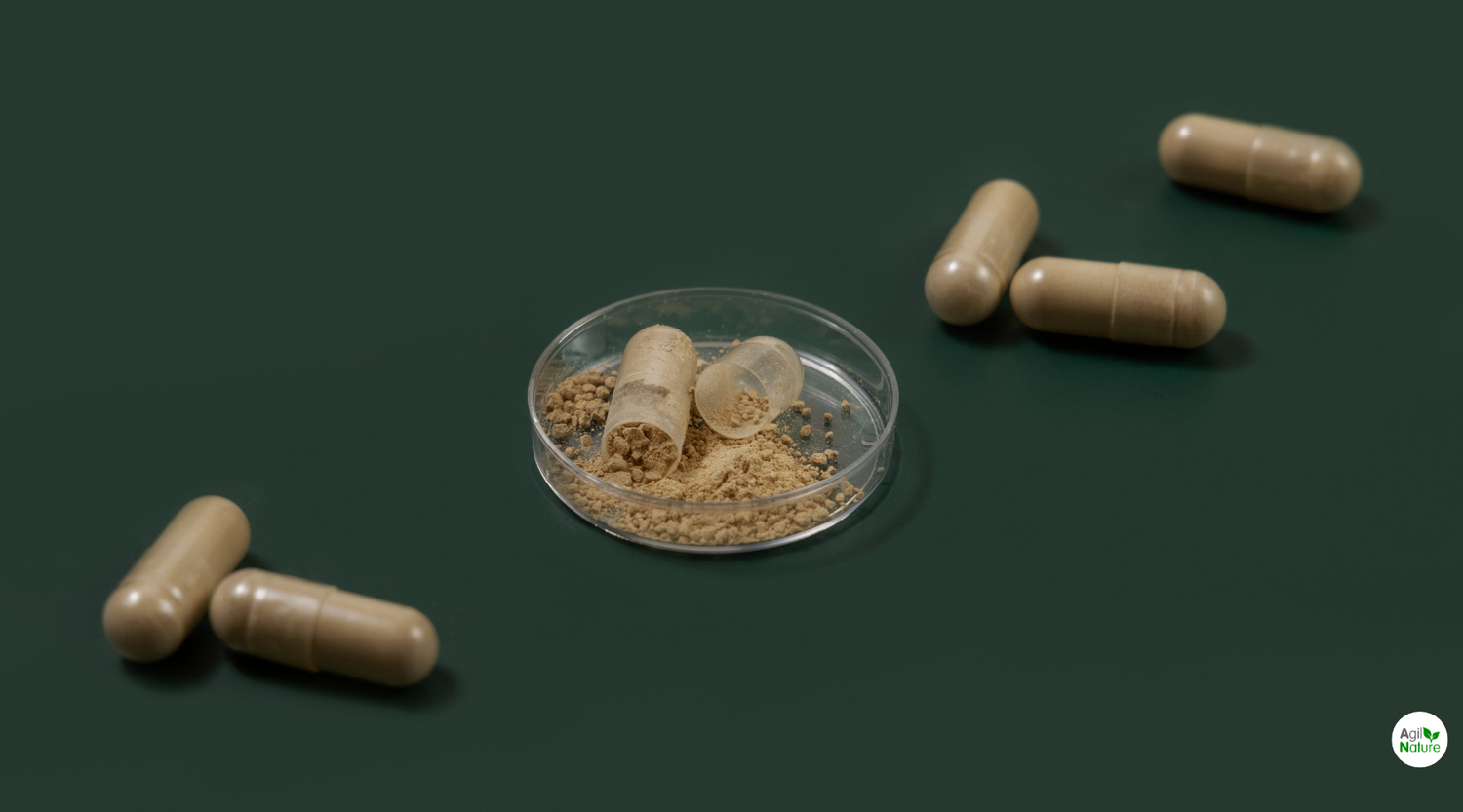
What happens to dietary supplements after they are taken?
What happens to dietary supplements after they are taken?
Dietary supplements are an integral part of a health-conscious lifestyle for many people. However, the key question is: What happens to supplements immediately after ingestion? This article details the physiological pathway of a supplement, including the key factors influencing bioavailability, the role of individual differences, and the relevance of high-quality product formulation.
Transit through the stomach and small intestine: First steps of digestion
After oral ingestion of a dietary supplement, the substance first passes through the esophagus and enters the stomach. There, it undergoes initial processing by gastric acid (HCl) and the enzyme pepsin. These dissolve the physical shell of tablets or capsules and release the active ingredients. Pharmaceutical factors such as tablet hardness, coatings, or encapsulation techniques significantly influence the rate of release.
Formulations such as enteric-coated capsules are designed to allow the release of sensitive substances only in the small intestine. This protects heat- or acid - labile substances such as certain probiotics, omega-3 fatty acids, or some B vitamins. Furthermore, gastric fill level influences the transit time: An empty stomach accelerates gastric emptying and thus release, while a full stomach can delay the process.
Interestingly, the pH value in the stomach, which is influenced by age, diseases (e.g. gastritis) or medication (proton pump inhibitors), can also change the stability and release of the ingredients.
Absorption mechanisms in the small intestine
The main absorption occurs in the small intestine, particularly in the jejunum and ileum. Various transport systems are active here:
-
Passive diffusion (lipophilic molecules)
-
Carrier-mediated transport (e.g. glucose, amino acids, calcium)
-
Active transport (e.g. vitamin B12 with intrinsic Factor , iron via DMT1)
-
Endocytosis (e.g. large protein complexes or liposomal structures)
Bioavailability , defined as the proportion of an administered active ingredient that appears unchanged in the systemic circulation, is the key measure of the effectiveness of a supplement .
Role of bile acids and pH
Fat-soluble vitamins (A, D, E, K) require the presence of bile acids secreted from the gallbladder into the small intestine for absorption. These acids emulsify lipids and facilitate the formation of micelles, which solubilize the fat-soluble vitamins and facilitate their absorption. Coenzyme Q10 and curcumin also benefit from these mechanisms. A pH value in the small intestine that is too low or too high can significantly affect the activity of digestive enzymes and the solubility of certain minerals (e.g. zinc, magnesium).
Influence of substance combinations on bioavailability
Synergistic combinations can enhance absorption. Examples include:
-
Vitamin C and iron : Ascorbic acid reduces trivalent iron to divalent iron and promotes its absorption.
-
Vitamin D and calcium : Vitamin D stimulates the expression of calcium-transporting proteins in the intestinal epithelium.
Antagonistic interactions, on the other hand, can have an inhibitory effect:
-
Calcium and magnesium : Competition for transport mechanisms can reduce the absorption of both minerals.
-
Phytates and zinc /iron : Plant phytic acid ( e.g. in wheat and oats) can have a chelating effect and inhibit absorption.
Optimizing absorption through technology
New galenic concepts aim to specifically increase bioavailability. These include:
-
Liposomal encapsulation for fat-soluble substances
-
Micelle formation using emulsifiers
-
Nanoparticle technology to increase the absorption area
-
Bioenhancers such as piperine , which inhibit enzymes and increase intestinal permeability
Timed intake (e.g. fat-soluble vitamins with a main meal, water-soluble vitamins on an empty stomach) can also improve absorption.
Metabolism in the liver and systemic distribution
After absorption, the nutrients enter the liver via the portal vein, where phase I and phase II metabolism takes place:
-
Phase I: Functionalization by oxidation, reduction or hydrolysis (e.g. cytochrome P450 system)
-
Phase II: Conjugation with hydrophilic molecules such as glucuronic acid or sulfate groups
These processes influence the biological activity and half-life of the substances.
Only then does the systemic distribution via the bloodstream to the target tissues take place:
-
Bones (e.g. calcium, vitamin D)
-
Muscles (e.g. magnesium, creatine)
-
Immune system (e.g. zinc, vitamin C)
-
Nervous system (e.g. omega-3 fatty acids, B vitamins)
The distribution is determined by factors such as molecular size, lipophilicity, binding to transport proteins (e.g. transferrin, albumin) and the expression of cell-specific receptors.
Influence of quality on supplement effectiveness
The effectiveness of a dietary supplement is closely linked to the quality of the raw materials used and the manufacturing processes. Key quality characteristics include:
-
Raw material quality : High purity, standardized active ingredient levels, minimization of contamination (e.g. heavy metals, pesticides)
-
Optimization of absorption : improvement of bioavailability (e.g. liposomal encapsulation, bioenhancer )
-
Release profiles : Modified release (e.g. prolonged-release tablets) for consistent plasma levels
-
Synergistic formulations : Combined ingredients that enhance each other's effect and absorption
The timing of intake and the avoidance of antagonistic combinations are also crucial for individual effectiveness.
Conclusion: The complex path to effectiveness
What happens to supplements immediately after swallowing? – this question reveals a complex interplay of physiological processes.
The effectiveness of a dietary supplement depends on whether it efficiently manages the entire pathway from ingestion through release, absorption, metabolism, and distribution to interaction with target tissues. Only high-quality, scientifically sound supplements with optimized bioavailability can successfully overcome these hurdles and make a noticeable contribution to health.
A well-founded selection, adapted to individual needs, taking into account the latest nutritional findings, forms the basis for successful and safe supplementation in modern health management.
In the long term, understanding these processes is essential to further develop the responsible and effective use of dietary supplements in prevention and therapy.
Sources:
-
Greenwood-Van Meerveld , Beverley et al. “Gastrointestinal Physiology and Function.” Handbook of experimental pharmacology vol. 239 (2017): 1-16. doi:10.1007/164_2016_118
-
Boland, Mike. “Human digestion--a processing perspective.” Journal of the science of food and agriculture vol. 96.7 (2016): 2275-83. doi:10.1002/jsfa.7601
-
Brown, B. (2022) Bioavailability, food supplements, and clinical efficacy. Nutr . Med. J., 1 (2), 6-11.
-
Point Institute. (2020). Bioavailability: The forgotten key to health and wellness (White Paper). https://www.pointinstitute.org/wp-content/uploads/2020/06/Bioavailability.White-Paper-Final-6.30.2020-Updated.pdf
-
Sakshi Manocha , Shivani Dhiman , Ajmer Singh Grewal , Kumar Guarve ,
-
Nanotechnology: An approach to overcome bioavailability challenges of nutraceuticals, Journal of Drug Delivery Science and Technology, Volume 72, 2022, 103418, ISSN 1773-2247, https://doi.org/10.1016/j.jddst.2022.103418.

